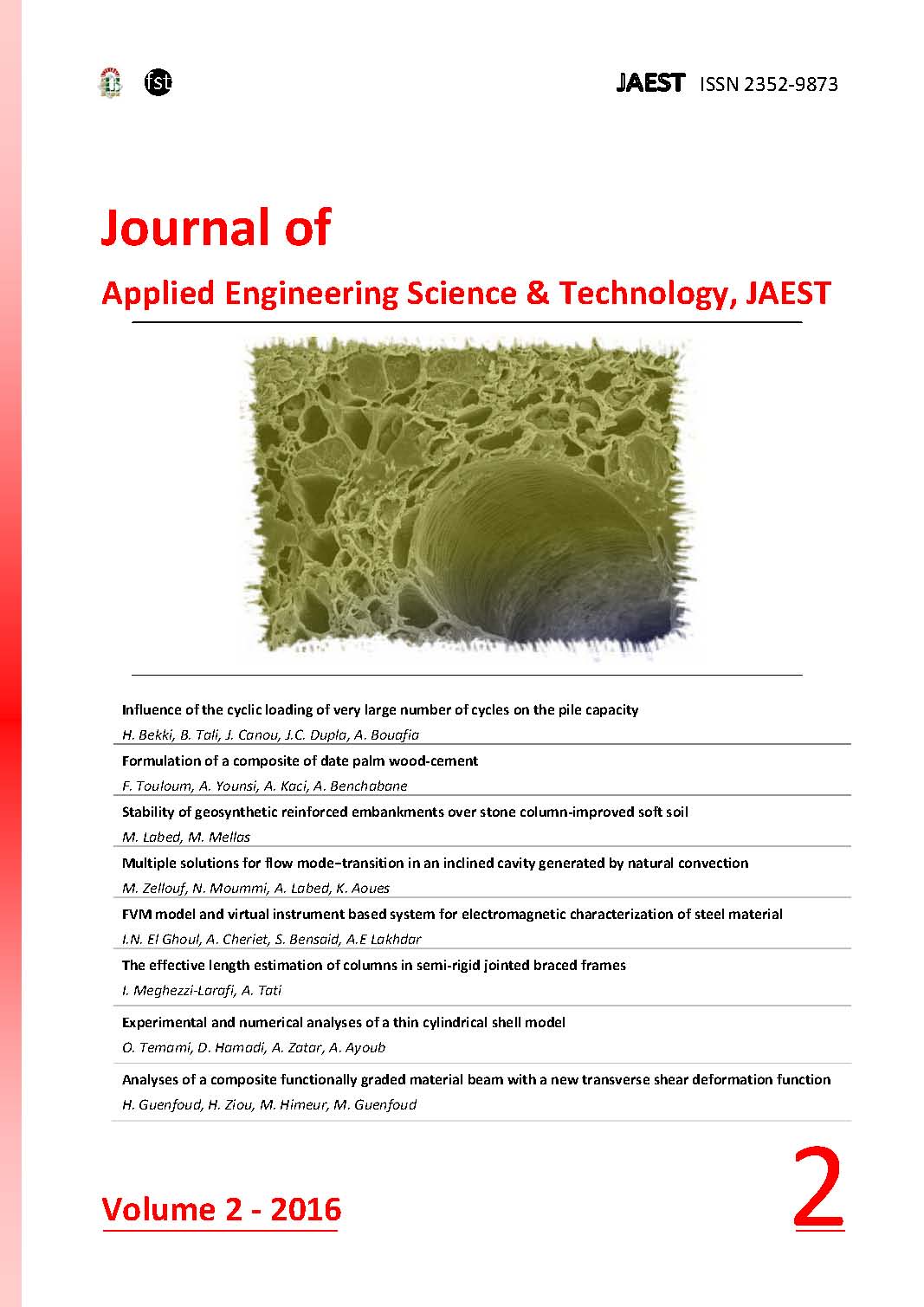DOI:
https://doi.org/10.69717/jaest.v2.i2.43Keywords:
Functionally Graded Material, Power-law, Finite Element Method, Timoshenko’s beam, Shear functionAbstract
In the present paper, we offer a higher-order shear deformation theory for bending of functionally graded beam. A new polynomial shear function is used which satisfies the stress-free boundary conditions (exact boundary conditions on the stress) at both, top and bottom surfaces of the beam. Hence, the shear correction factor is not necessary. Additionally, the present theory has strong similarities with Timoshenko beam theory in some concepts such as equations of movement, boundary conditions and stress resultant expressions. The governing equations and boundary conditions are derived from the principle of minimum potential energy. Functionally graded material FGM beams have a smooth variation of material properties due to continuous (unbroken) change in micro structural details. The variation of material properties is along the beam thickness and assumed to follow a power-law of the volume fraction of the constituents. Finite element numerical solutions obtained with the new polynomial shear function are presented and the obtained results are evaluated versus the existing solutions to verify the validity of the present theory. At last, the influences of power law indicator and the new shear deformation polynomial function on the bending of functionally graded beams are explored.
Downloads
Downloads
Published
Issue
Section
License

This work is licensed under a Creative Commons Attribution-NonCommercial 4.0 International License.
How to Cite
Similar Articles
- Hamza Djeffal, Mohamed Nadir Amrane, Numerical modeling of the prestressing losses in prestressed concrete beams by modal analysis method , Journal of Applied Engineering Science & Technology: Vol. 4 No. 2 (2018): JAEST
- Hicham Mokhbi, Mekki Mellas, Abdelhak Mabrouki, Jean‐Michel Pereira, Numerical study of a vertical pullout capacity of strip anchor plate on a frictional soil , Journal of Applied Engineering Science & Technology: Vol. 2 No. 1 (2016): JAEST
- Houdayfa Ounis, Mohamed-Ouejdi Belarbi, On the thermal buckling behaviour of laminated composite plates with cut-outs , Journal of Applied Engineering Science & Technology: Vol. 3 No. 2 (2017): JAEST
- Mohamed-Ouejdi Belarbi, Abdelouahab Tati, Abdelhak Khechai, Houdayfa Ounis, A new 4-node quadrilateral element based on layerwise approach for free vibration analysis of laminate-faced sandwich plates , Journal of Applied Engineering Science & Technology: Vol. 2 No. 1 (2016): JAEST
- Islam-Ncereddine El Ghoul, Ahmed Cheriet, Samir Bensaid, Ala-Eddine Lakhdari, FVM model and virtual instrument based system for electromagnetic characterization of steel material , Journal of Applied Engineering Science & Technology: Vol. 2 No. 2 (2016): JAEST
- Mohamed Baheddi, Youcef Youb, Study of the behavior of bridges under seismic loads considering soil-structure interaction , Journal of Applied Engineering Science & Technology: Vol. 1 No. 2 (2015): JAEST
- Salah Zerguine, Djamel Benmeddour, Abdallah Zatar, Numerical study of seismic earth pressures acting against a vertical retaining wall in frictional soil , Journal of Applied Engineering Science & Technology: Vol. 2 No. 1 (2016): JAEST
- Mohamed Rezig, Kamel Srairi, Mouloud Feliachi, Lotfi Alloui, New designs systems for induction cooking devices for heating performances improving , Journal of Applied Engineering Science & Technology: Vol. 3 No. 2 (2017): JAEST
- Oussama Temami, Djamal Hamadi, Abdallah Zatar, Ashraf Ayoub, Experimental and numerical analyses of a thin cylindrical shell model , Journal of Applied Engineering Science & Technology: Vol. 2 No. 2 (2016): JAEST
- Mohamed Labed, Mekki Mellas, Stability of geosynthetic reinforced embankments over stone column‐improved soft soil , Journal of Applied Engineering Science & Technology: Vol. 2 No. 2 (2016): JAEST
You may also start an advanced similarity search for this article.





